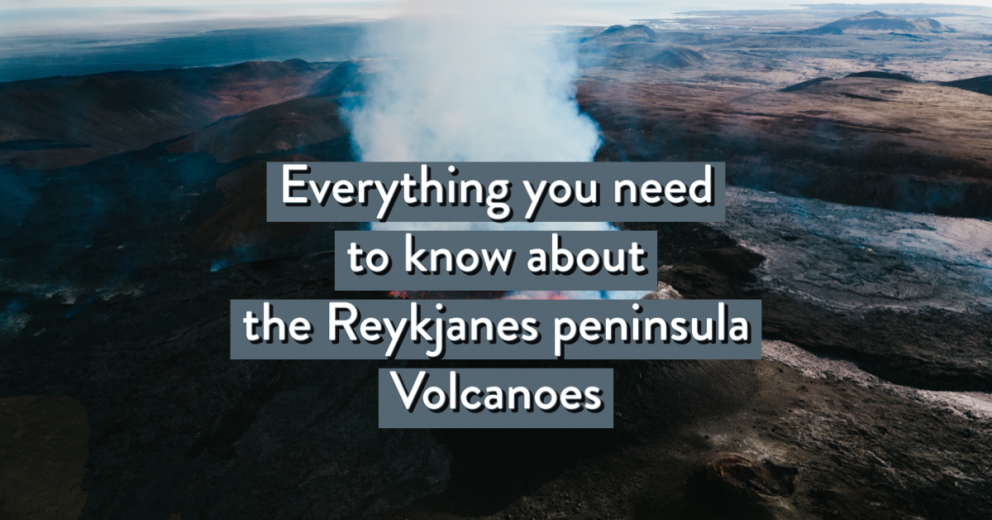Everything you need to know about the Reykjanes Peninsula volcanoes
Reykjanes
Reykjanes is the furthest south west of the country’s land-based volcanic systems. However, it begins underwater, where the Reykjaneshryggur volcanic system forms the end of the submarine section of the Mid-Atlantic Ridge. Once on land, the system continues in a SW-NE direction. The landscape is characterised by Holocene lava flows – in other words, they’ve been formed since the last Ice Age. This volcanic system was fairly active in the 12th and 13th centuries and you’ll still see rows of basalt craters and small shield volcanoes. Svartsengi, located closer to the Blue Lagoon, is also often spoken about as part of Reykjanes volcanic system, but probably taps into a separate magma chamber.
Eldey
Offshore and further to the south west, Eldey is classed as a separate volcanic system. Scientists consider Eldey, Eldeyjardrangur, Geirfugladrangur and Geirfuglasker to be remnants of prehistoric underwater eruptions. Since 1211, there have been six eruptions, lasting anywhere from a few days to several weeks. The initial trio took place in 1211, 1340 and 1422 near Eldey. In 1879 they were followed by another eruption close to a rocky reef called Geirfuglasker, with tephra deposits recorded on the mainland near Hafnir. Two more near Eldey in 1884 and 1926 rounded off the activity – for now at least. All of these except the eruptions in 1879 and 1926 created new islands which rose out of the sea as the magma built up. They didn’t last long, falling apart under the battering they received from the waves during ferocious North Atlantic storms.
Krýsuvík-Trölladyngja
The Krýsuvík-Trölladyngja volcanic system is classed as a moderately active one. Visit the area today and you’ll witness fumaroles, boiling mud pots and hot springs; there’s also plenty of sulphur in the ground. It runs under Kleifarvatn and so the presence of water from this lake means that there’s a chance of shallow explosions creating features called maars. These broad, low craters form when magma gets into the groundwater, causing it to heat up really fast and then burst upwards. In terms of more significant eruptions, historians can confirm lava flowed out of the Ogmundargigar crater in the 12th century and that there was another eruption a couple of years later. The area covered by this system is broadly a linear one stretching SW-NE. It was originally a shield volcano, a flatter landform than the classic cone volcanoes you often see elsewhere. Though in the past, basalt lava flows have reached both the north and south coast, when activity does occur, it tends to be effusive. In layman’s terms, that means that any lava flows are relatively slow and steady. Of course, that’s good news for local residents and the authorities tasked with keeping them safe, as it allows time to make considered actions and if it comes to it, an orderly evacuation.
Fagradalsfjall
Vulcanologists had a clue something unusual was happening in 2020 when many earthquakes happened within a relatively small area on the Reykjanes Peninsula. Scientists measured inflation and deflation in the land, which often means magma is rising and falling below the surface. Eventually, on March 19th 2021, an eruption began, and that magma had built up to such an extent that it was forced up and out. Following that 2021 eruption, scientists have concluded that Fagradalsfjall is a separate volcanic system from Krýsuvík-Trölladyngja. It’s relatively low-lying and a little different to its neighbours, with no clear SW-NE fissure and no geothermal field. Originally it was thought of as a secondary fissure swarm connected to the main one – a second crack in the surface from which magma might push through. But given that the most recent eruptions have been quite significant, it’s no surprise that the two systems are treated differently, as it means the Krýsuvík-Trölladyngja can be given a green light for visitors while monitoring continues at Fagradalsfjall in case of further eruptive activity.
Brennisteinsfjöll
It’s been a while since the last documented eruption of the Brennisteinsfjöll volcanic system, sometimes referred to as Bláfjöll (Blue Mountains). There’s no central volcano in this volcanic system and at its highest point it only measures about 700 metres above sea level. A line of craters stretches for around 45 to 50km in a SW-NE direction, connecting Geitahlíð peak to Hæðir ridge, which lies west of Þingvallavatn. Activity in Iceland’s early years was referred to as “fires” and although there are written records, they’re not very precise. It is possible that these small eruptions could have lasted, on and off, for decades, but what we do know is that they most likely took place in the 10th and 11th century and probably to the south west of the system. The magma has a high sulphur content, and there are records that suggest the stench from volcanic activity disrupted parliamentary proceedings over in Thingvellir.

